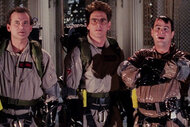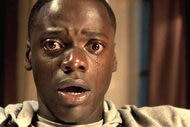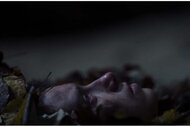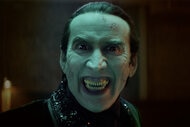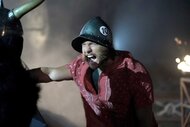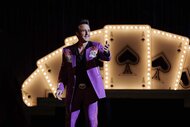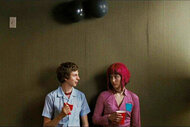Create a free profile to get unlimited access to exclusive videos, sweepstakes, and more!
How The Baby-Sitters Club subverts and empowers the witch-next-door trope

Rumors of haunted houses or neighbors with the power to cast spells are a fixture of suburban-set TV shows and movies. A rundown building or an older adult who lives alone will spawn terrifying legends that get passed on from one kid to the next. Did you know a witch lives on this block?
The Addams Family, Bewitched, and even the recent Chilling Adventures of Sabrina play with the convention of regular families with spooky abilities, and the Neibolt House in It takes this notion to the creepy abandoned extreme. A tragedy involving a dead or missing child often provides a far less supernatural reason for the dilapidation or reclusive behavior of a much-talked-about figure. However, the trauma of reality is less entertaining than supernaturally tinged hearsay. It is also easy to believe something sinister is going on behind closed doors because the fairy tales we are told as children often feature a creepy old crone with an ulterior motive. Rather than leaning into the stereotypes, the witch-next-door trope is getting an empowering twist in the new Netflix adaptation of Ann M. Martin’s iconic tween book series, The Baby-Sitters Club.
**SPOILER WARNING! Spoilers ahead for The Baby-Sitters Club.**
“A witch lives next door to us. Her name is Morbidda Destiny. She put a spell on Boo-Boo, our cat,” Karen Brewer (Sophia Reid-Gantzert) tells her new babysitter Mary Anne Spier (Malia Baker) in the opening episode. It is the first gig for the new club — hired by Kristy Thomas’ soon-to-be stepfather — and this statement sounds like nothing more than the wild imagination of a 7-year-old girl. Not to mention, Karen’s morbid curiosity extends beyond rumors of the neighborhood witch.
She is well-versed in all the classic urban legend tropes, telling Kristy (Sophie Grace) the phantom calls she is receiving on Halloween are probably being made from inside the house. An unnerving comment to make at the best of times, but this conversation occurs mid-wake for her atheist doll Krakatoa. (“You lived. Now you’re dead.”)
It should come as no surprise that young minds turn to the macabre, considering that the first witches we encounter in stories are often derived from a Brothers Grimm-style depiction. They are women living in the center of a forest, waiting for unsuspecting children so they can feast on their flesh. Alternatively, a sorceress might trick a couple into giving away a child, or their motives are driven by the desire for eternal youth. Regardless of intent, the spinster should be feared.
Folk stories, whether told over a campfire in 17th-century New England or a Disney movie from the last 75 years, portray witchy women as the villain. Cautionary tales meant to protect children also have a way of vilifying a particular kind of person. Karen thinks it is pretty cool that a witch lives next door until she sees this woman officiating the wedding between her dad and Elizabeth Thomas-Brewer (Alicia Silverstone). The ear-piercing scream of terror reveals just how much she fears the proximity of the woman she calls Morbidda Destiny.
Shifting from a terrifying threat to a positive influence, the evolution of the witch figure in society mirrors how pop culture presents the spell-casting women to us. First, they will devour your soul as a small child before becoming a symbol of empowerment as we grow older.
After Karen’s extreme reaction, Esme (Karin Konoval) — aka Morbidda Destiny — matter-of-factly explains, “This little girl thinks I’m a witch. So in front of this room full of witnesses, I would like to say that she’s right.” Plot twist! Or rather, it would be if we hadn’t already seen Esme hosting a spiritual gathering in an earlier episode. However, before this official introduction, our first interaction is when she yells at Kristy for standing in her hedge while spying on Mary Anne's babysitting gig. Appearing somewhat terrifying (although Kristy was trespassing), at the time Karen nonchalantly explains this is her Wiccan-next-door.
First impressions don't always sync up with reality, but in the case of Esme, Karen was right about her spiritual calling, even if she isn't the kind of witch Karen envisioned. In Episode 4, Mary Anne attends what she believes is “some kind of all-female cookout” with her new friend Dawn Schafer (Xochitl Gomez). When she realizes the host — and Dawn's aunt — is none other than Morbidda Destiny, Mary Anne is unnerved by this unfamiliar situation.
Dawn’s mom jokes that Esme wishes her witch name was this cool moniker before confirming she is, in fact, a witch. Trying not to freak her pal out too much, Dawn adds this version of the word is more like a “spiritual healer” and this is their goddess welcome ceremony. Unlike anything Mary Anne has ever attended, the whole publicly-baring-your-soul element sends her spinning. In "Mary Anne Saves the Day," the naturally shy tween has found herself questioning her sensitivity to conflict, and while she doesn’t take part in the “new moon sharemony,” this meeting is an empowering moment that leaves its mark.
At this transitional period in the burgeoning teenagers' lives, having a role model like Dawn's aunt Esme and her mom is vital in broadening their outlook on the power of femininity. Dawn's bond with her mother and aunt is absent in Mary Anne's upbringing since her mother died when she was 18 months old. Her father is understandably protective over his only daughter. An injection of confidence via the woman who isn’t a scary witch-next-door but a regular witch-next-door is an important first step.
In Jumanji: Welcome to the Jungle and teen classic Now & Then, a tragedy involving a missing or dead child has led to the exile of an adult from the community. Neighborhood kids give out names like Crazy Pete and the "Freak House" without consideration regarding the real backstory. We still don't know much about Esme's personal history, but the lack of spinster references or dead kid mentions feels somewhat transformative, as does the notion she is a practicing witch but without extraordinary abilities like the Spellmans or Samantha Stephens. While the fantasy of changing an outfit with the flick of a finger is enticing, joining hands with our moon sisters and having a tarot card reading are accessible to all.
After confirming her witchy status to the wedding congregation, she gives a mini-TED Talk about how the word "witch" has historically been weaponized against people (mostly women) "who refuse to conform to society's expectations of who they should be." Observing there are a lot of witches in attendance (met with a rapturous reaction from the back), she ends this brief aside by intoning, "When children tell you something, believe 'em." Instead of belittling Karen's visceral reaction, she advocates for her and avoids the stereotype that characters like Esme hate kids.
Sprinkling some much-needed wisdom and a valuable lesson in wielding words, she isn't stealing the matrimonial ceremony spotlight while performing her officiator duties. Rather, it is an empowering interjection that speaks to the tweens, teens, and adults who hold witch-figures close to their hearts. There is no greater magic gift than this.






